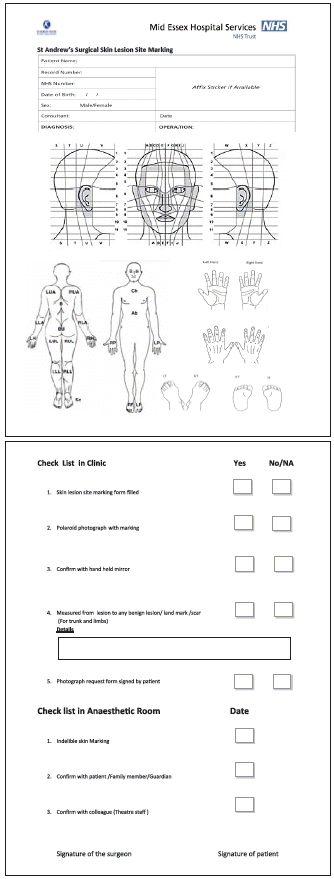A multistep approach to preventing wrong site surgery in skin lesion excision
Article information
Wrong site surgery (WSS) is a never event and preventable error. It is well documented in various surgical specialties like urology, orthopedics and general surgery. There however is no reported data of outcomes of WSS in plastic surgery in the United Kingdom. We conducted a survey to assess the current incidence, factors involved and current protocols in place for plastic surgery units in both the United Kingdom and Ireland. We also devised an algorithm that is used at our unit currently that aims to reduce the incidence of WSS over a period from 2016 to 2018.
Sixty-six plastic surgery services in the United Kingdom and Ireland were contacted. The survey included incidence of WSS, anatomical location of lesion, level of experience of surgeon involved, related factors, any system in place to prevent WSS and any suggestions by the respondents on additional ways to avoid these events. The survey was sent to clinical leads of all plastic surgery units in the United Kingdom and Ireland by email.
We received replies from 19 of 64 clinical leads (30% response rate). In 42% of units (8/19) had experienced WSS. The number of such cases in the last 5 years varied with 26% (5/19) reporting one case, 10% (2/19) two cases, and 5% (1/19) three cases. The grade of surgeon involved included 7of 19 consultants, 2 of 19 specialty doctors, 1 of 19 registrars and 0 of 19 senior house officers. Factors influencing WSS included wrong site marking by surgeon 20% (4/19) and failure to check the notes 20% (4/19) were the commonest causes. Other factors included checklist failures 10% (2/19), transfer of patient care to other surgeons 10% (2/19), inaccurate theatre lists 5% (1/19), failure to mark 5% (1/19), and failure to discuss with the patient 5% (1/19). Systems described that were already in place included: use of the World Health Organization (WHO) checklist, preoperative marking by operating surgeon, or team briefing prior to list and operation commencing.
The incidence of WSS has been estimated at one out of 112,994 procedures; however, the number of unreported cases is estimated to be higher [1]. We introduced a strict guideline/protocol at our institute. A surgical grid form (Fig. 1), developed at our institute, identifies the anatomical site of surgery on the form printed with a line diagram in which the lesion is marked. A checklist on the other side of the surgical grid form confirms whether a photograph is taken after consent from the patient, whether confirmed with the patient by mirror, confirmed with distance from anatomical points to the site of lesion. On the day of surgery, the following steps are taken: (1) the clinic letter review, (2) reviewing the notes, (3) checking the line diagram in the notes, (4) clinical photograph of the lesion, (5) surgical grid form (anatomical marking form), (6) confirming site of surgery with the patient, (7) marking the lesion with indelible ink, or (8) confirming with colleagues in the anesthetic room before patient being taken into theatre. With the above steps, we have drastically reduced our WSS rate at our unit and hope others may follow suit.

Wrong site surgery prevention sample sheet used by St. Andrew’s Centre for Plastic Surgery and Burns for skin lesion excision. LUA, left upper arm; RUA, right upper arm; B, back; BU, buttock; LLA, left lower arm; RLA, right lower arm; LH, left hand; RH, right hand; LUL, left upper leg; RUL, right upper leg; LLL, left lower leg; RLL, right lower leg; Ch, chest; Ab, abdomen; RP, right palm; LP, left palm; LT, left; RT, right; NA, not applicable.
Notes
Conflict of interest
No potential conflict of interest relevant to this article was reported.
Author contribution
Conceptualization: N Mopuri, Q Frew, CYY Loh, P Dziewulski. Data curation: N Mopuri, Q Frew, CYY Loh. Formal analysis: CYY Loh, P Dziewulski. Methodology: N Mopuri, CYY Loh. Project administration: N Mopuri, CYY Loh, P Dziewulski. Visualization: N Mopuri, CYY Loh, P Dziewulski. Writing - original draft: N Mopuri, CYY Loh. Writing - review & editing: N Mopuri, Q Frew, CYY Loh.
